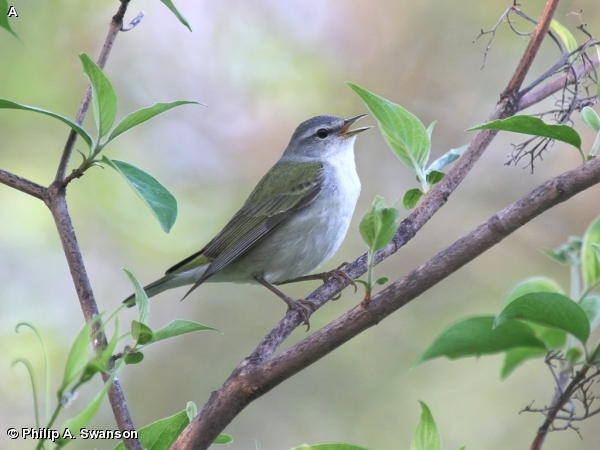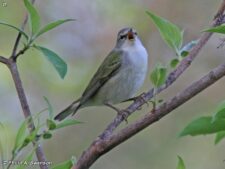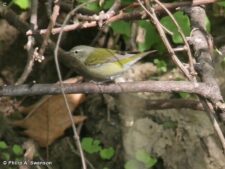
4.75” long. The Tennessee Warbler is a short-tailed and plump bodied bird. It is one of our more plain warblers. The bill is thin. In spring the male has a dark eyeline with a bold white eyebrow. It also has a greenish back, gray crown, unstreaked white breast, white belly, and white undertail coverts. The greenish wings usually do not have wing bars although occasionally there may be faint wingbars. The male usually has white tail spots while female does not have white tail spots. The spring female is similar to the male but her head is less gray and there is a yellowish wash to the eyebrow, throat, and breast. Fall adults are more olive-green above with more yellow on breast. Fall immature birds are yellow-green above, yellow on breast, and sometimes yellow on the belly. The undertail coverts are generally white but can have a slightly yellow tinge. The Tennessee Warbler can be confused with an Orange-crowned Warbler, but the Orange-crowned always has yellow undertail coverts. Orange-crowns also have a stronger split eye ring with overall a less distinctive face. The Tennessee Warbler also can be confused with a Philadelphia Vireo, but the vireo has a much more stout bill and has sluggish movements compared to a warbler.
The Tennessee Warbler is a common in migration. Seen in spring from late April through late May. Also seen from late August through late October.
The Tennessee Warbler is rather active and nervous foraging at all levels. It sings tirelessly. The song is 2-3 phrases of loud staccato repeated accelerating notes.
Disclaimer: The content of NatureSearch is provided by dedicated volunteer Naturalists of Fontenelle Forest who strive to provide the most accurate information available. Contributors of the images retain their copyrights. The point of contact for this page is: Phil Swanson.


